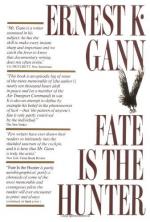|
This section contains 628 words (approx. 2 pages at 400 words per page) |

|
Fate is the Hunter Summary & Study Guide Description
Fate is the Hunter Summary & Study Guide includes comprehensive information and analysis to help you understand the book. This study guide contains the following sections:
This detailed literature summary also contains Topics for Discussion and a Free Quiz on Fate is the Hunter by Ernest K. Gann.
Ernest K. Gann, the author of the autobiography, learned how to fly in the earliest days of aviation. He attended flight school and was trained as one of the first commercial pilots in the United States of America. He flew commercial routes in New England for a few years prior to World War II. Then, throughout the war, he flew as a civilian pilot for the Air Transport Command. After the war, he found the return to short flights in New England somewhat boring and joined a startup company flying between California and Honolulu. Although he enjoyed working for the company, it failed. He then worked for another company performing unscheduled long flights in the South Pacific. During this period the Korean War was fought, and Gann once again flew the men and materiel of war. After the Korean War Gann continued flying for a few more years until he felt that his own fate with death was approaching; to avoid death, he retired from flying.
The autobiographical text is arranged chronologically and is told with an open, bluff voice that has the ring of experience and honesty. Gann examines his own life and his own minor role in the developing field of commercial aviation prior to, throughout, and after World War II and the Korean War. The autobiography features anecdotes and descriptions of dozens of other aviators who are specified only by last name. In the introductory matter, Gann notes that several names have been deliberately altered. The text is presented with a vague sense of historical time; no specific dates are mentioned throughout. Thus, the book must be historically fixed in time solely by the references made to world events—the surrender of Germany and, later, Japan in World War II, the appearance of various models of aircraft in commercial circles, the occurrence of the Korean War, and so forth.
The autobiography is tightly themed around the notion of fate: that is, accidents happen when they are fated and do not happen when they are not fated. The prologue illustrates the point when Gann makes a minor altitude correction for no apparent reason and the action unquestionably saves his life. The text presents many other similar incidents. The chapters are subsequently presented chronologically: Gann goes to school and obtains commercial certification; he is assigned as co-pilot on commercial flights; he works alongside several experienced pilots and gains experience and credibility until he is an accomplished pilot in his own right. Gann then considers the philosophy of flight and discusses several memorable events in detail. For example, one flight to Greenland is presented in remarkably poetic language. Gann's autobiography then continues with another lengthy section of factual events, including flights during and after World War II, inter-war flights, and flights during and after the Korean War. Throughout this entire prolonged period, Gann's luck is good and his fate holds out. He then describes in detail one unsettling event—two planes suffer the same mechanical failure: one of them crashes with a loss of all hands, but Gann's plane lands safely. Clearly his fate is forestalled, but he wonders for how long. In the end, Gann flies alongside a veteran co-pilot and studies the man. As he does so, Gann comes to realize that his personal fate is only partially within his own control—he has flown too far and too long, he has escaped too many tight spots, too many others have died—and soon enough his fate will claim him. At that moment, he determines to quit the life of a pilot and the autobiography quickly concludes. Far more than just an autobiography, the book is widely appreciated as an authoritative monograph on the early history of aviation.
Read more from the Study Guide
|
This section contains 628 words (approx. 2 pages at 400 words per page) |

|



